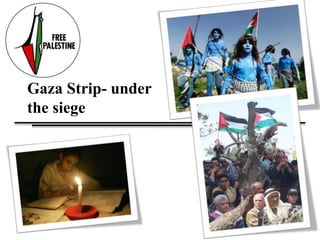Gaza strip under siege
- 1. Gaza Strip- underthe siege
- 2. Gaza Strip: overview Total Area 365 (km2) ~Incheon 964 (km2) Estimated Population 1,486,816~ Incheon 2,710,579Population Density 4,073 (Capita/km2) ~ Incheon 2.8 (Capita/km2) Percentage of Population Less than 15 Years 44.9%The average age in Gaza Strip is 17.6 years of age. 92% of them can read/write.Percentage of Population over 65 Years 2.5%Unemployment 38 - 43.%2
- 3. Gaza Strip: overview 3Gaza Strip is an occupied territory by international law. The Fourth GenevaConventions that relate to the protection of civilians under any occupation by a foreign power points out that:âNo protected person may be punished for an offence he or she has not personally committed. Collective penalties and likewise all measures of intimidation or of terrorism are prohibitedâĶ Reprisals against protected persons and their property are prohibitedâĶâ
- 4. Gaza Strip Siege4Gaza Strip is suffering since mid June 2007 from a tight Israeli closure and collective punishment, which is about to result in a humanitarian catastrophe
- 5. The Humanitarian Crisis in GazaFood/PovertyWaterHealth/MedicineTradeIndustryPower5The UN currently provides food assistance to 80% of the population in Gaza StripThe United Nationâs Office of Coordination for Humanitarian Affairs (OCHA) released by the end of 2007 very alarming figures about the humanitarian crisis in Gaza.
- 6. Food and materials 6GOODS ALLOWED INTO GAZA Canned meat and tuna, but not canned fruit Mineral water, but not fruit juice Sesame paste (tahini) but not jam Tea and coffee but not chocolate
- 7. The Humanitarian Crisis in Gaza7IndustryNearly 90% of all industrial establishments(3,500 out of 3,900) have shut down since mid-June 2007, either temporarily or permanently, including the most significant factories located at Karni Industrial Zone.TradeDue to the import restrictions of equipment and spare parts, 40% of Gazaâs municipality vehicles and 600 containers need urgentreplacement.
- 8. Gaza's Electricity CrisisThe problem started on June 2006, when the Israeli Air Force destroyed all six transformers at the GPP by air strike.5 months later, GPP worked again with 65MW then reduced to 35MW, comparing to the full capacity of 140MWAfter Hamas take-over, more restriction were applied by Israel.Gaza people must cope with scheduled electricity cuts of 8-12 hours daily, compared to 6-8 hours prior to January 2010.Exacerbate the already difficult living conditions in Gaza Affecting: Hospitals and clinics, Water and sanitation, Education, and Agriculture8
- 9. Agriculture in Gaza Strip Military attacksRestricting basic agricultural inputsSeeds and seedlings, Plastic piping, Water pumps/filters/irrigation pipes, Fishing nets, Engine spare parts, Veterinary drugs, CementClosed borders 9
- 10. Agriculture: Olives and olive oilOlives and olive oil are one of the main sources of income for the Palestinian economy.source of income for around 100,000 farming families.10 million olive trees, with 34,000 metric tons of olive oil in a good year. However, US$100 million annually [NGO Oxfam ]Israeli actions, Restricting access to land.Settlers attacks farmers and olive trees (10,000 trees were distorted in 2010) 10
- 11. Agriculture: Olives and olive oil11
- 12. Agriculture: Olives and olive oil12
- 13. Agriculture: Olives and olive oil13
- 14. My message to Koreans and All over the world 14Our kids future must be with hope, or it will be disaster.The solidarity with Palestinian cause, contributes to their hope.
- 15. Thank You15










![Agriculture: Olives and olive oilOlives and olive oil are one of the main sources of income for the Palestinian economy.source of income for around 100,000 farming families.10 million olive trees, with 34,000 metric tons of olive oil in a good year. However, US$100 million annually [NGO Oxfam ]Israeli actions, Restricting access to land.Settlers attacks farmers and olive trees (10,000 trees were distorted in 2010) 10](https://image.slidesharecdn.com/gazastrip-undersiege-101223101152-phpapp02/85/Gaza-strip-under-siege-10-320.jpg)




